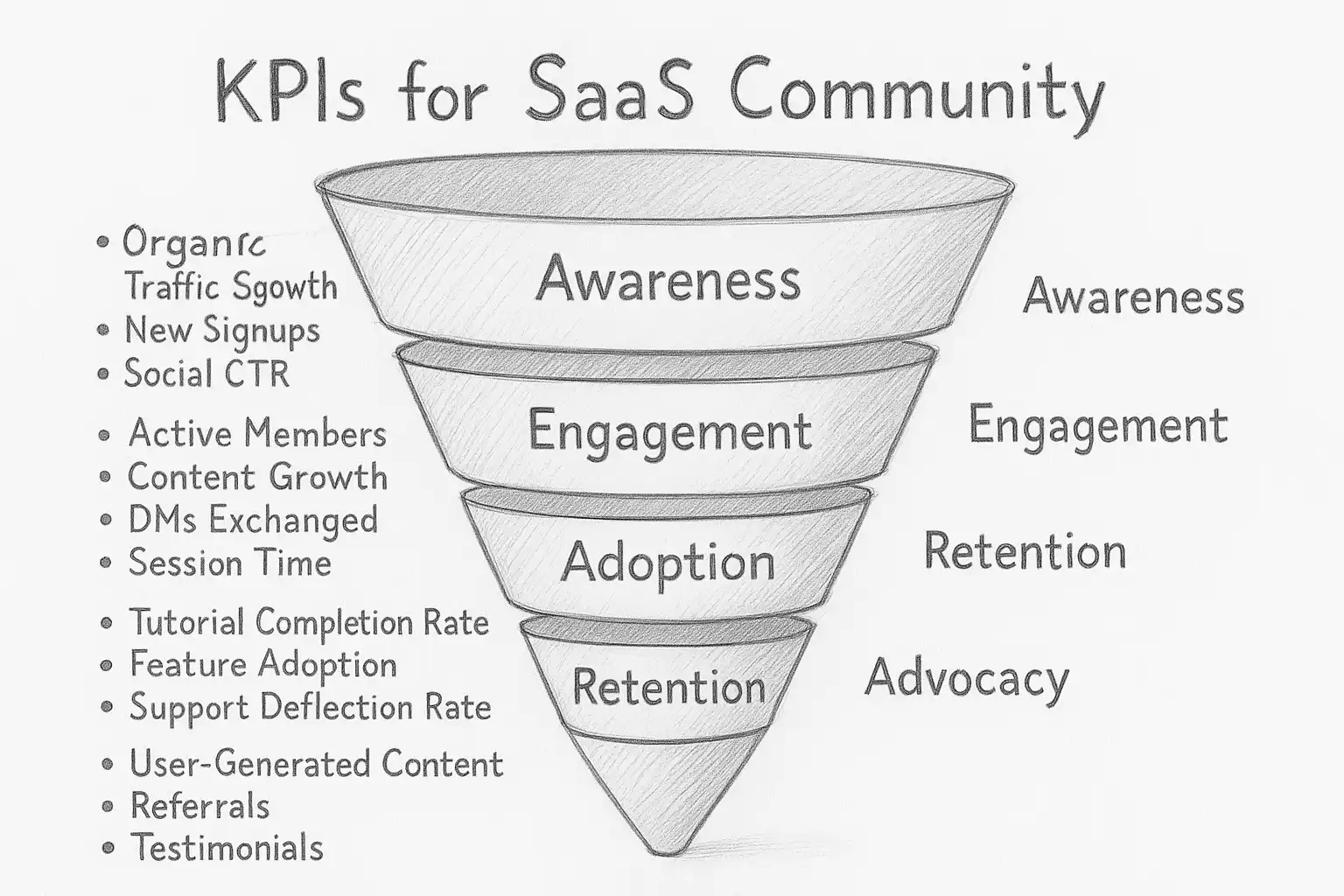KPIs for SaaS Community: Measure What Matters

I’ve spoken with about 50 SaaS founders about their community building efforts. Here’s a fact - Building a SaaS community is no longer optional.
In the AI-dominated world, customers don’t just want software. They want support, knowledge, and connection with real humans. A well-run SaaS community can drive user adoption, reduce churn, and create loyal brand advocates.
Community building often feels ‘slow’, but it’s the highest RoI asset your business can ever have.
When it comes to community - there are 100s of KPIs (Key Performance Indicators) you can track. But if you aren’t measuring the right ones, you won’t know if your community is working. Read - KPIs for Community Growth.
Vanity metrics like “total members” or “number of posts” only scratch the surface. What you really need are KPIs that connect community activity to SaaS growth.
Community Activity → SaaS Growth
In this article, I’ll walk you through the essential KPIs for SaaS communities, broken down into five stages of your marketing funnel:
Awareness
Engagement
Adoption
Retention
Advocacy
I’ll also share practical examples from real SaaS companies that built thriving communities.
Why KPIs Matter for SaaS Communities
Before diving in, let’s answer the big question: why track KPIs in the first place?
A SaaS community can serve multiple purposes: it can attract new users, onboard them faster, reduce support costs, and build loyalty. But unless you measure outcomes, you won’t know what’s driving business results.
Tracking KPIs helps you:
Align community goals with business goals.
Identify what’s working (and what’s not).
Prove ROI to leadership.
Build a roadmap for community-led growth.
Now, let’s break down the KPIs that really matter.
1. Awareness KPIs
A SaaS community must attract the right audience before it can deliver value (Read : SPACES Model) . Awareness KPIs measure visibility, reach, and discoverability.
Key Metrics to Track
Organic traffic growth – Measure community visitors from search engines. Communities like HubSpot Academy thrive because their content ranks on Google and compounds over time.
New signups attributed to community – Track how many SaaS users or free trial customers discover your product via community content.
Social CTR (Click-Through Rate) – Measure how often community posts, newsletters, or webinars are shared and clicked.
Pro Tip: Keep most of your community content public (70–80%). This lets Google index discussions and user-generated content (UGC), turning your community into a self-sustaining traffic engine.
2. Engagement KPIs
Engagement is at the core of a SaaS community. If people aren’t participating, you don’t have a community: you just have silent signups.
Key Metrics to Track
Active members (DAU/MAU) – A quick pulse check of your community’s health.
Content growth (posts, replies, comments per member) – Watch for contributions from non-staff members - this signals true peer-to-peer value.
Direct messages (DMs) exchanged – Thriving communities like Notion’s foster private conversations, which strengthen networks and make communities sticky.
Average session time – Longer time spent = higher value perceived. If users binge on tutorials and discussions, they’re more likely to stay engaged.
Why it matters: Engagement KPIs show if your community is building connections strong enough to influence customer success.
3. Adoption KPIs
Your SaaS community should accelerate product adoption. This is where business impact becomes very clear.
Key Metrics to Track
Tutorial / guide completion rate – Measure how many members finish onboarding flows, knowledge base content, or product learning paths.
Feature adoption influenced by community – Did a new feature see higher usage after being explained in community webinars or AMAs?
Support deflection rate – Zendesk found that active communities can deflect up to 30% of tickets. Track how many support questions are resolved via community discussions instead of 1:1 tickets.
Why it matters: Adoption KPIs show whether your community is reducing friction, boosting learning, and making customers more successful with your SaaS.
4. Retention KPIs
Acquiring customers is expensive. Retaining them is where SaaS businesses win. Communities play a key role in reducing churn and building loyalty.
Key Metrics to Track
Churn rate difference – Compare churn between customers active in your community vs. those who aren’t. Communities often cut churn significantly.
Return rate – Track how often members return to your community monthly or quarterly.
NPS (Net Promoter Score) – Use periodic surveys (every 6–12 months) to measure satisfaction and likelihood to recommend.
Example: Figma’s community reduced churn by offering design templates and peer-to-peer learning that kept users engaged beyond the product itself.
5. Advocacy KPIs
The holy grail of community is advocacy. Advocacy means your members are actively promoting your SaaS without being asked.
Key Metrics to Track
User-generated content (UGC) – Count tutorials, templates, guides, or integrations created by members.
Referrals – How many new users are being referred by active community members?
Testimonials – Track endorsements, reviews, and product shout-outs.
Case study volunteers – Members willing to feature in webinars, events, or case studies.
Example: Webflow’s community drives massive adoption through user-generated templates and tutorials, which lower the barrier for new users.
Putting It All Together
Here’s a simplified SaaS community KPI funnel:
Awareness: traffic, signups, social reach
Engagement: activity, contributions, DMs, session time
Adoption: feature usage, support deflection, tutorials
Retention: churn reduction, repeat visits, NPS
Advocacy: referrals, testimonials, UGC
Tracking this funnel ensures your SaaS community isn’t just active: it’s delivering measurable business growth.
Final Thoughts
The best SaaS communities don’t obsess over vanity metrics. They focus on KPIs that tie directly to product adoption, retention, and revenue.
Key takeaway: Measure the right KPIs, and your SaaS community transforms from a “support forum” into a growth engine.
If you’re building a SaaS community today, start with awareness KPIs, move to engagement and adoption, and scale towards retention and advocacy. That’s the path to real ROI.
Recommended Reading: Community Outreach KPIs (LinkedIn)